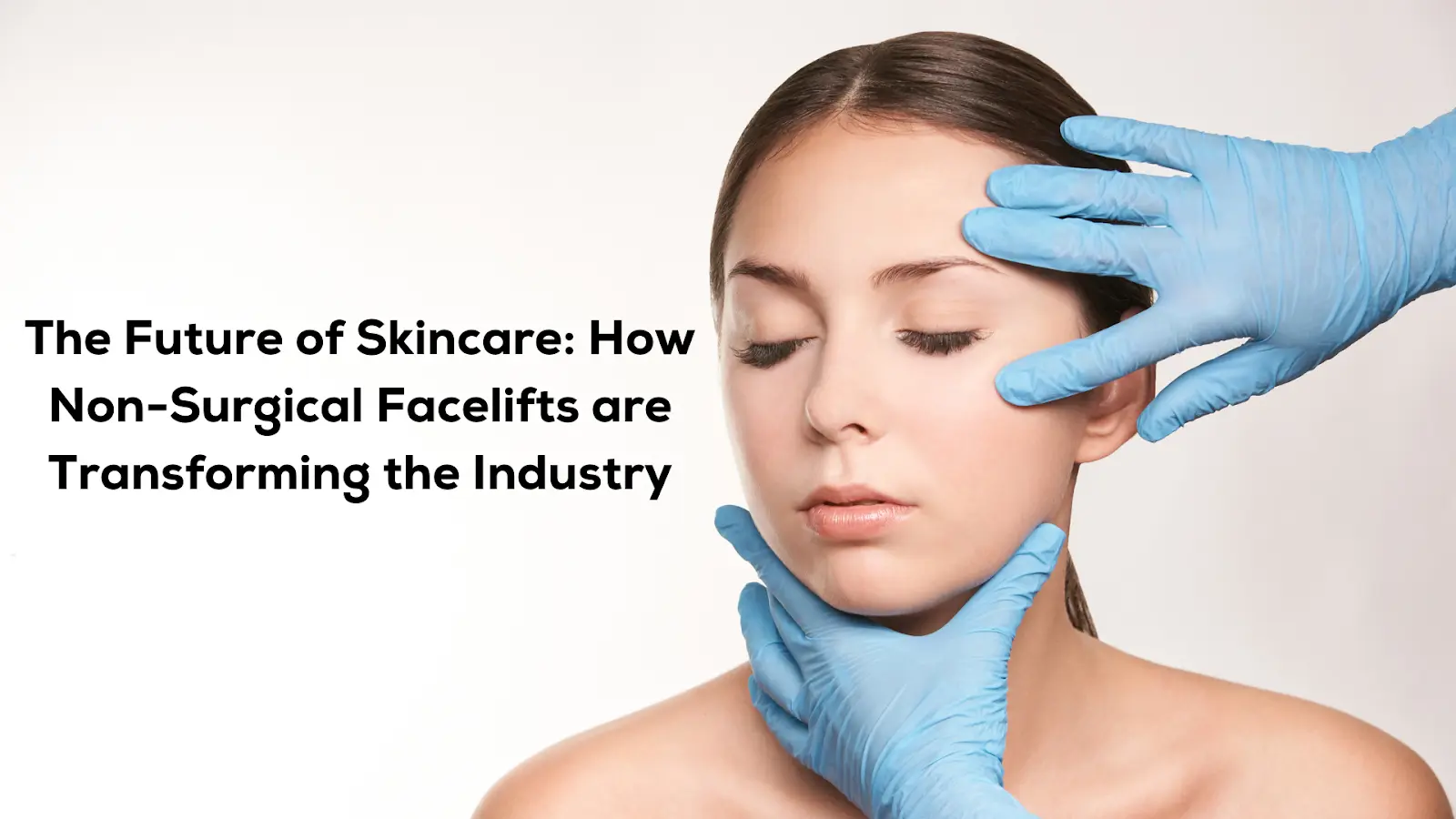The skincare industry is undergoing a major transformation. This is due to the rise of non-surgical facelift procedures. They serve as alternatives to traditional surgical facelifts. These innovative treatments leverage advanced technology to achieve facial rejuvenation, yielding natural-looking results. The best part is that they involve little to no downtime. This article delves into the following aspects:
- Changing industry of skincare
- Examining the technology
- Advantages
- Growing popularity
- Future directions of non-surgical facelifts
The Technology Behind Non-Surgical Facelifts
Ultherapy: Ultrasonic Skin Tightening
Ultherapy uses focused ultrasound waves. It stimulates collagen production deep within the skin’s foundational layer. Studies show a 42.5% increase in collagen levels after three months of treatment. Ultherapy is an FDA-cleared option for non-invasive skin tightening. It has an 86% patient satisfaction rate according to RealSelf.
Radiofrequency (RF) Therapy
RF energy heats tissue beneath the skin’s surface to encourage new collagen and elastin production. These treatments have grown 58% from 2012-2021 according to the American Society of Plastic Surgeons. Devices like Thermage show 89% improvement in skin laxity. This improvement rate is based on data from the Journal of Drugs in Dermatology.
Microneedling with Radiofrequency
This process combines microneedling with RF technology. This non-surgical facelift option stimulates collagen production. At the same time, it creates micro-injuries to further encourage skin regeneration and tightening. Studies show a 36.6% increase in skin tightness using this approach. There is a 94% patient satisfaction rate.
The Advantages Of Traditional Surgical Facelifts
Minimally Invasive Nature
Non-surgical facelifts have the advantage of being minimally invasive. Meanwhile, traditional surgery is known to be more invasive. A non surgical facelift only needs small injections or external devices. That way, it can deliver targeted energy beneath the skin. Non-surgical facelifts do not involve long incisions or extensive injections. This reduces risk and trauma.
With non-surgical options, patients experience little disruption. They get treated over a lunch break before resuming normal activities. There is only 1-2 days of average downtime per ASPS data. Meanwhile, surgical facelifts demand anesthetization. They also need an extended recovery of 2-4 weeks post-procedure as incisions mend. This considerable burden of surgery deters many from choosing it.
Beyond downtime, statistics also spotlight surgery’s higher complication rates. Facelifts carry a 1.7% risk of issues like the following:
- Infection
- Scarring
- Anesthesia-related risks
Meanwhile, there is only a 0.2% risk of those issues seen in non-surgical counterparts. This data came from the Aesthetic Surgery Journal. As less invasive options continue advancing, more seek facial rejuvenation through nonsurgical means.
Natural-Looking Results
Surgical facelifts treat severe laxity. However, overly aggressive tightening can lead to unnatural expressions. This is an infamous symptom dubbed as the ‘windblown look’. Non-surgical options spare patients this outcome through precise, fractional resurfacing, and collagen stimulation. This avoids trauma to surrounding tissue. The subtle and gradual improvements from these treatments integrate. As a result, patients are left with beautiful, believable enhancements.
The ASPS revealed the following in one survey. 88% of prospective patients emphasized desiring natural-looking results. It is considered a priority over dramatic transformation. Non-surgical facelifts cater well to this preference. That is because of their delicate, tissue-sparing techniques. These aim to complement patients’ natural beauty rather than overhaul it.
Cost-Effectiveness
Besides convenience and safety advantages, non-surgical facelifts also prove more financially accessible. Clocking in at roughly 60% less expensive than surgical alternatives per ASPS data.
Ending facial laxity through surgery demands hefty costs from the following:
- Anesthesia
- Operating room fees
- Overnight stays
Meanwhile, non-surgical treatments incur fewer ancillary charges. This translates to thousands in savings. Recovery also takes days not weeks, reducing the impact on work and personal lives. It is far quicker and less disruptive. Nonsurgical options make facial rejuvenation financially and practically achievable for more patients.
The Growing Popularity of Non-Surgical Facelifts
Recent years have seen non-surgical facelifts gain considerable popularity. This is all thanks to the following factors:
- Celebrity testimonials
- Shifting demographics
- Strong industry investment
Stars like Jennifer Aniston and Courtney Cox praise these treatments. As a result, Google searches for “non-surgical facelifts” have climbed 72% since 2017. This data came from Google Trends. And it has sparked widespread curiosity.
Once dominated by older consumers, 40% of procedures now cater to millennials and Gen Xers. Brief recovery enables patients to resume normal activities. non-surgical facelifts appeal to wider age ranges.
In response to this trend, major companies are investing heavily in research and product development. The global non-surgical facelift market size approaching $72.33 billion by 2030. Leading brands actively funnel resources into extra research and product development. That way, they can meet demand according to Cosmetic Surgery Times.
Addressing Common Concerns
Despite its advantages, non-surgical options also raise fair questions about the following:
- Safety
- Longevity
- Practitioner qualifications
Thankfully, research continues to yield positive findings.
Side effects like temporary redness or numbness may occur. However clinical studies reinforce non-surgical procedures as safe when properly executed. The following measures help mitigate risks:
- Careful screening
- Precise techniques
- Avoidance of unqualified providers
Results depend on factors like skin type and age. But usually, patients enjoy improvements for 9-12 months before considering maintenance. Multi-session treatments also prolong aesthetic benefits.
Verify medical credentials like board certification. It enables the selection of vetted, skilled practitioners for optimal safety and satisfaction.
The Future of Non-Surgical Facelifts
Ongoing Innovation:
Continued research and testing aim to improve non-surgical results further. That way, it can keep serving superior skin tightening, lifting, and rejuvenation. Emerging therapies could one day shift more procedures away from the operating room:
- Injectable skin-tightening polymers
- Non-invasive fat elimination
- Advanced laser resurfacing
Additionally, other breakthrough technologies are currently in the process of FDA trials. These may also enable consumers to enjoy subtle rejuvenation at home. An example of this is smartphone-connected at-home fractional treatment devices. Paired with telehealth consulting, such innovations could dramatically expand access and autonomy.
Lengthy clinical testing ensures rigorous standards for safety and efficacy. But the fast pace of technology suggests a bright future ahead. More people seek facial enhancement without surgery’s risks, costs, and recovery.
Potential Regulatory Shifts
Non-surgical skincare technology continues to mature. As such, regulatory shifts may further aid adoption. It can approve devices and treatments for settings beyond specialized clinical facilities including:
- Medispas
- Beauty clinics
- Homes
Ensuring responsible oversight remains crucial. Increased FDA clearance of non-surgical treatments could mirror a movement in the dental industry. It is transitioning teeth alignment from orthodontist offices into convenient at-home options.
Similar decentralization in the coming years may empower aesthetic patients. They can enjoy subtle skin solutions under existing healthcare providers. They might be able to do so directly as consumers as well. Greater autonomy and choice seem probable as regulators respond to safety advancements.
Conclusion
Non-surgical facelifts are rapidly emerging as a new norm. It is all thanks to the following factors:
- Minimal disruption
- Low cost
- Safety
- Significant patient demand
Non-surgical facelifts serve as disruptors, empowering more individuals to pursue skincare solutions on their own terms. The best part is they can do it on their terms. Although certain questions remain, the steady pace of technological advancement promises an expanding array of options in the coming years. This is most beneficial for those hoping to turn back time aesthetically.
Frequently Asked Questions:
Can non-surgical facelifts provide results comparable to traditional surgical facelifts?
Surgical facelifts treat more advanced aging-related laxity. However, non-surgical options offer noticeable improvements for mild to moderate concerns:
- Stimulating collagen
- Smoothing fine lines
- Contouring facial features through energy-based treatments
Surgical outcomes tend to last longer. But non-surgical facelifts provide subtle rejuvenation with no recovery tradeoffs.
Are there any age restrictions or limitations for those seeking non-surgical facelifts?
Historically targeting older demographics, non-surgical facelifts today appeal to broader age segments. They now include younger generations. That is because treatments create only minimal disruption versus surgery. Benefits vary with the severity of skin laxity and damage. However, skilled practitioners can tailor treatment plans to individual needs, moving beyond rigid age constraints. Maintenance may be required sooner for youthful skin.
What risks or side effects are associated with non-surgical facelifts?
When done correctly, the majority of patients report no lasting side effects or complications. However temporary soreness, swelling, or redness can occur after more invasive options. Qualified providers adjust the intensity to avoid burns and maximize safety. To further reduce risks, the following practices should be used:
- Proper patient screening
- Precise techniques
- High-grade equipment










Hello!! My name is Annabella
I love to eat, travel, and eat some more! I am married to the man of my dreams and have a beautiful little girl whose smiles can brighten anyone’s day!